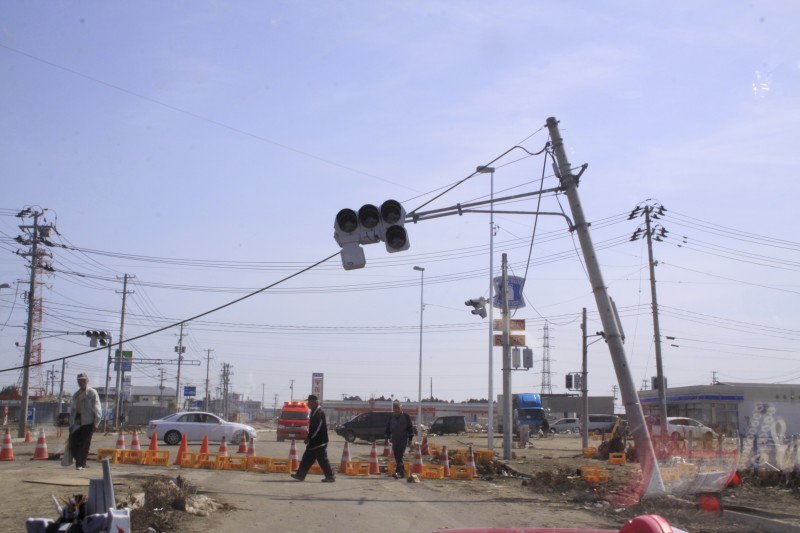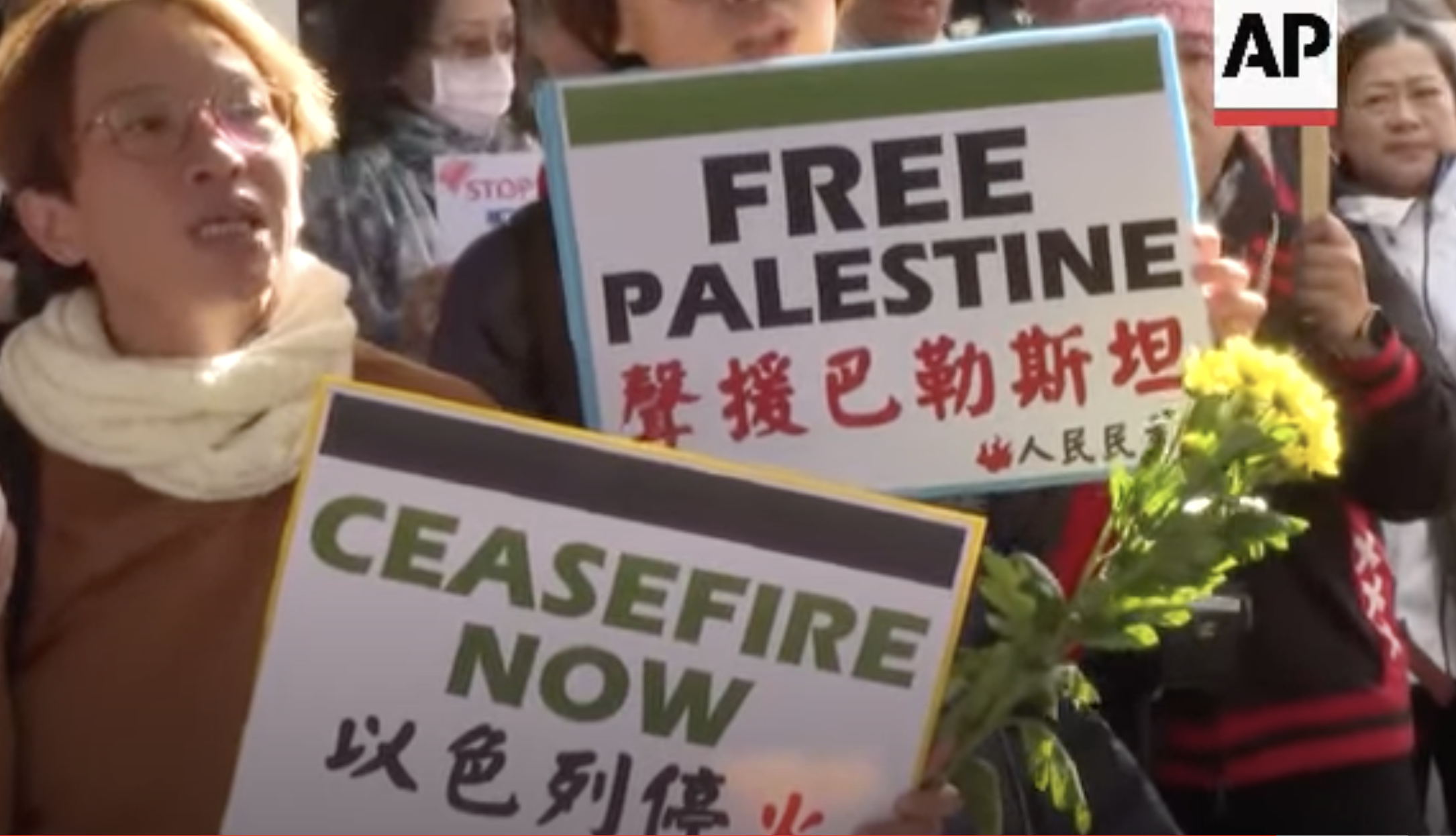
Image by Flickr user NATSUKO KADOYAMA from March 14, 2011. CC BY NC-ND 2.0
A 6.8-magnitude earthquake rattled Japan's Nagano Prefecture in November 2014. Forty-one people were injured and 54 buildings collapsed, making for sensational coverage in the media.
【余震も】長野北部の地震 家具が倒れ、道路に亀裂 新幹線は緊急停車(画像) http://t.co/VKEvzWka1w pic.twitter.com/MRPEUVMvdw
— ハフィントンポスト日本版 (@HuffPostJapan) 2014, 11月 23
Aftershocks: The earthquake in northern Nagano has left furniture strewn in cracked streets. Shinkansen bullet train services were suspended.
However, there was not as much media coverage of the recent Nagano quake compared to the past. One reason may be that no one died in the recent Nagano earthquake. While the media was quick to report on the Nagano quake, in-depth reporting afterwards quickly trickled off.
Even though a relatively strong 6.8-magnitude earthquake had occurred, the approach to coverage had changed. People took notice of the reduced coverage and voiced their opinions online.
これだけの規模の地震なのに、テレビが地震慣れし過ぎて、速報からすぐに、ワイドショーネタに、すぐさま戻ってしまったのが、とても怖い事態だと思うんだが…
— TETSU (@mediaplaning) 2014, 11月 22
Although the earthquake scale was large, the fact that television coverage quickly switched back to prime time programming is pretty scary.
On the other hand, countless tweets about the earthquake were produced in a steady stream. Some Twitter users were wondering about the dearth of media coverage about the quake, while others were wondering why it was so easy to brush off such a big quake.
地震が来ても恐怖に怯えるどころかなんかtwitterが賑わうあたり日本って地震慣れしてる感ある
— kamini. (@kamini_doll) 2014, 11月 22
With all of the Twitter chatter expressing fears of another quake, it's easy to understand that Japan has become a country that has become used to earthquakes.
‘It's crazy that we've become used to this’
Japanese attitudes toward earthquakes certainly seem to have changed by the experience of the “3.11 Tohoku Triple Disaster“, referring to the deadly March 11, 2011 earthquake and tsunami that triggered a meltdown at the Fukushima Daiichi nuclear power plant.
As the earthquake that occurred Nagano in November 2014 illustrates, people living in Japan have become used to earthquakes (indeed, there is actually a new expression in the Japanese language that describes this phenomenon, 震慣れ (jishin-nare) or “used to earthquakes.”)
On Twitter, relatively large earthquakes like the one that occurred in Nagano this past November would have at one time would have been taken quite serious. Nowadays there isn't as much of a sense of fear and anxiety being expressed there or on other social media networks.
震災の前はちょっとした地震も怖くて、震度3とか死ぬと思ってたくらい本当に怖かったんだけど、あの震災の地震を体験してそれ以降もずっと頻繁に揺れてたからびくともしなくなった。慣れってこわい。だから震度4でも普通にテレビみてる自分あぶないって思う
— 宮地☆みっちゃん (@sajun1022) 2014, 11月 22
In the past, people thought even small tremors were scary. People thought they were going to die even if it was a mild Shindo 3 earthquake. After experiencing 3.11 and following the incessant aftershocks in years since, that anxiety has disappeared. Earthquakes are scary, but we're used to them. So when I'm still calmly watching television even in the middle of a Shindo 4 quake, well, that's a little strange and unsettling.
Other Twitter users think the attitude of society itself towards earthquakes has changed since 3.11:
東北の地震くらい凄いものを体験したからなのか今回も凄い地震が長野で起きている筈だけど感覚が麻痺?何なのか東北の時みたいにザワザワしたままじゃなく割と普通に生活を送ってしまっている辺り慣れ?の感覚って怖いなぁって思う。
— Rei@11/25ぼっちキャラクロ (@Re1o627) 2014, 11月 23
Is it because the 3.11 Tohoku Triple Disaster was so terrible that we've come to expect that the Nagano quake will also result in terrible damage? It's almost like we as a society are in a state of paralysis. It's not like with the Tohoku triple disaster, when there was a constant background hum of discussion about what was happening. In the case of the Nagano earthquake this past November, people just resumed their daily lives. It's quite chilling to think about.
The sense of passivity in the face of crisis was already apparent to some observers just one year after the 3.11 Tohoku disaster.
Thanks to frequently occurring aftershocks even in regions far away from the most severely affected regions of Tohoku, regular, relatively frightening quakes which would have once upon a time been considered abnormal were now just regular life for many people.
岩手県沖震源で震度4か。普通なら大きな地震なんだけど、もはや報道すらあまりない。慣れって恐ろしい。麻痺してるんだ。
— John Neo (@Johnneosan) 2012, 7月 29
A M4 earthquake just off the coast of Iwate (about 300 km north of Tokyo). Normally this would have been considered a big deal but there's hardly any coverage. It's crazy that we've become used to this. As a society we have become numb.
As the word word 慣れ (nare, to become accustomed to) spread to become a meme in the months of aftershocks following the 3.11 Tohoku Triple Disaster, many expressed their unease at what this word was actually coming to represent.
海外の建物なんて日本で言う震度3でも全壊してしまうのもザラにあります。「地震慣れ」なんて寝ぼけたこと言ってないで建物から離れましょう。それは「慣れ」ではなく「麻痺」です。
— 妙見@12/20クリーマクラフトパーティ (@myoken11) 2012, 8月 31
In other countries, it's pretty common for even a relatively minor Shindo 3 earthquake to collapse buildings. When an earthquake happens don't say you're “used to earthquakes.” Instead, seek safety. You're not “used to earthquakes”, you have simply become numb to them.
Note: Instead of the measuring by magnitude, Japan classifies earthquakes according to a “seismic intensity scale,” or shindo (literally “degree of shaking”). Although the shindo system doesn't measure the depth of an earthquake (which helps determine seismic intensity), it's possible to measure the effect of the same earthquake across different regions. A Shindo 7 earthquake like the one that struck off the coast of Tohoku generating massive tsunami waves is the most powerful earthquake.
Survivors’ noble stoicism
The perception of earthquakes in Japan is also connected to how people who themselves have been affected by earthquakes perceive what has happened to them.
In the weeks and months that followed the 3.11 calamity, aftershock after aftershock rocked eastern Japan, including the Tokyo region. The two words that have become most associated with the aftermath of the 3.11 triple disaster that completely wiped away so very many small towns off the face of the map were “reconstruct!” and kizuna, or “the bonds that tie us together as a community.”
However, as time went on, both the idea of reconstruction and kizuna have faded away, so much so that by 2013 that the journalist Ishijima Teruyo remarked that “the problem with the aftermath of the disaster is that only the word kizuna, or bond, itself remains, obscuring all that needs to be done to help the region recover.”
Ishijima reported listening to a university lecturer say, “The stoicism of the people of Tohoku is often presented as a moving and impressive tale, and that's the only story that is being told about the people living in the regions affected by the earthquake, tsunami, and nuclear disaster. And just a year after the disaster people were not able to hold out for much longer.”
Obscuring the very real suffering under a veneer of noble stoicism, the heartwarming story of the pluck and bravery of the 3.11 survivors has created an illusion. The themes of “strength” and “beauty” have obscured the real, ongoing plight of the people of Tohoku.
Just five days after the 3.11 earthquake and tsunami, the drive to understand what had happened was already being eclipsed by “concern” about the effects of the earthquake. As one Twitter user observed:
言い方がちょっと変だけど、地震への「関心」は高まったけど「意識」が低くなった気がする。決して震度5、6が小さいわけじゃない。被害者数だって「あの県は1人しか死者がでてない」じゃなくて、1人の人間が亡くなってしまった。すごく大きいことだ。慣れは怖い。
— 味噌汁 (@iam_misosoup) 2011, 3月 15
The way people are talking about 3.11 is changing subtlety. “Feeling for the victims of the disaster” is becoming more important than actually understanding what happened. Shindo 5 and 6 earthquakes are not small at all. We shouldn't be saying “only one person died in such-and-such place because of the earthquake.” One person dying in this day and age because of an earthquake is a big deal. Becoming accustomed like this to earthquakes is a very scary thing.
Political props
Following the 3.11 disaster, there were also many examples of earthquake victims being used as political props. In the lead-up to elections, politicians, in an effort to demonstrate they emphasized with people in the disaster zone, would criticize the attitudes and actions of other politicians towards earthquake survivors.
Other times, when the government itself was being criticized, such as at anti-nuclear demonstrations, politicians would position themselves as the foremost advocates of the 3.11 survivors.
Twitter users have been quick to notice:
大雪の時に天ぷらを食べてたとか昼のバラエティー番組にでたとか、相変わらず安部総理への下らない批判を繰り返す野党。仮設住宅に入れない被災者が何万人もいるならともかく、仮設住宅に何万人住もうが、それを理由に首相の行動が制約される理由はない。いい加減三陸や福島の政治利用はやめて欲しい。
— 高木 史郎 (@TakagiShirou) 2014, 3月 21
The opposition parties continue with their impotent criticisms of the [Prime Minister Shinzo] Abe government while ignoring the tens of thousands of people in the disaster zone still waiting for temporary housing. The politicians should leave the people living in the disaster zone out of politics
Yamamoto Taro, a television personality-turned politician who gained notoriety after ignoring protocol by passing on a letter to the emperor, has also been criticized for making political hay out of the plight of Tohoku residents.
山本太郎がたった1通の手紙を渡しただけで「天皇を政治利用した」と批判するのなら、その前に「天皇」も「拉致被害者」も「東日本大震災の被災者」も「福島第一原発事故の被害者」もカタッパシから政治利用してる安倍晋三のことを批判しろよ。
— きっこ (@kikko_no_blog) 2013, 11月 1
If we're going to criticize Taro Yamamoto for “politicizing the emperor” after passing on a single letter, we sure as hell had better criticize Shinzo Abe too for using the emperor as a tool for everything from North Korean abductions to the Fukushima nuclear accident and so on.
Others have noted that those who once claimed to champion the interests of those affected by the 3.11 disaster have now moved on.
反原発厨は、地震が起こると被災者への心配よりまず先に原発批判・自民批判を展開するのか。どっちが人でなしだか解らんな>RT
— 山極 由磨 (@YuumaYamagiwa) 2014, 11月 22
For the anti-nuclear movement, what seems to be more important than the plight of the 3.11 earthquake and tsunami survivors is criticizing nuclear power and the government.
Global Voices posts related to the 3.11 Tohuku Triple Disaster:
Strong Earthquake in Japan's Nagano Injures Dozens, Topples Homes
1,000 Days Since 2011′s Great East Japan Earthquake and Tsunami
20 Bitter Voices Rise From Fukushima After Japan's 2011 Nuclear Disaster
Mapping Earthquake Reconstruction in Tohoku, Japan
Fukushima: No Place Like Home
Earthquake Hits Awaji Island in Japan
Evacuate the Children of Fukushima
Fukushima's Children Are Getting Sick
Earthquake Debris Disposal Divides Japan
After Japan Earthquake, a New Local Newspaper by Citizens
Japan: Citizens Respond to New Nuclear Power Policies







1 comment